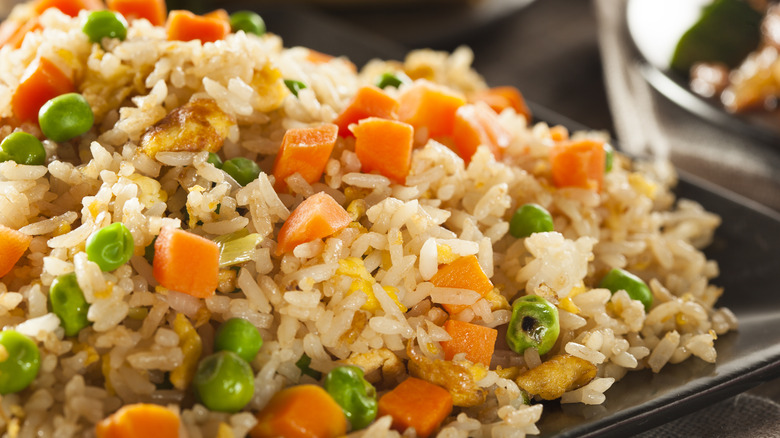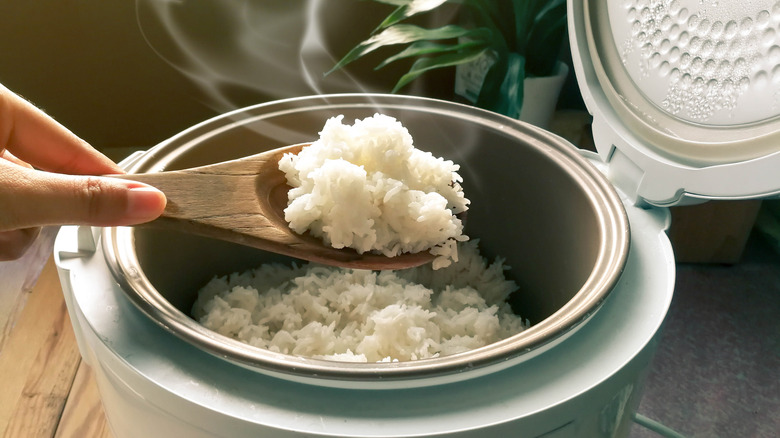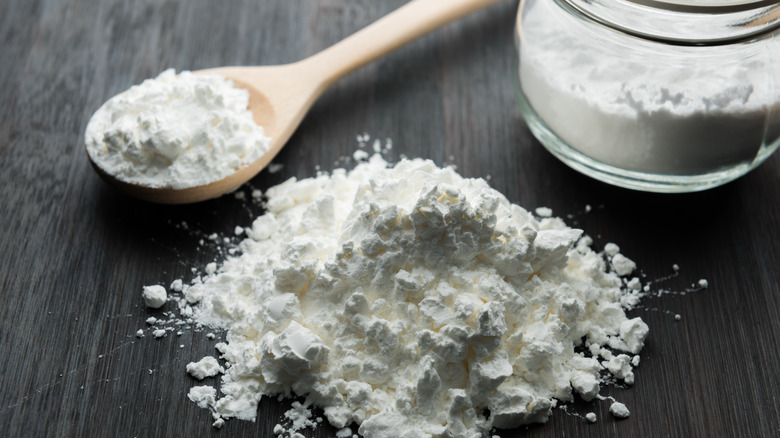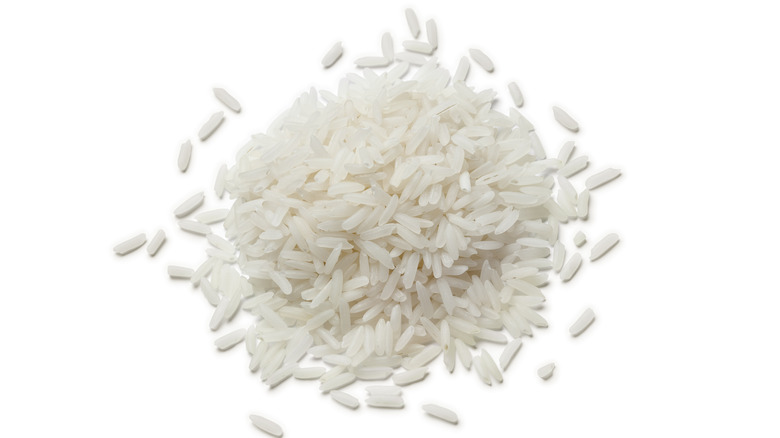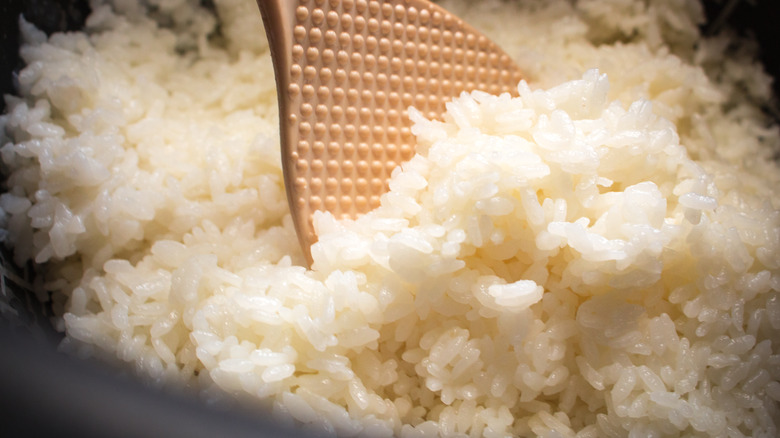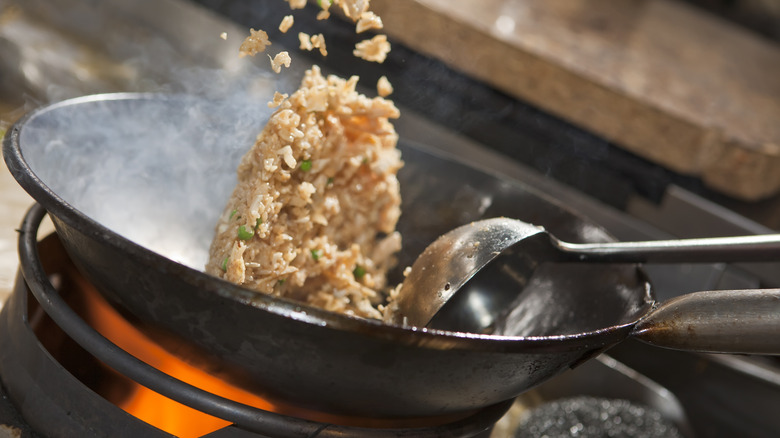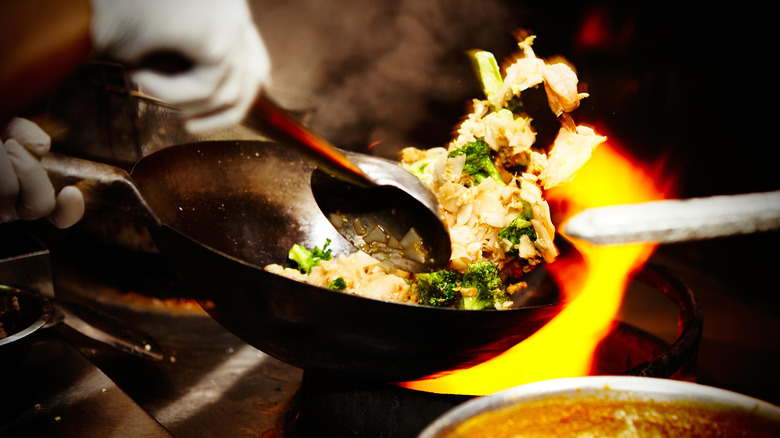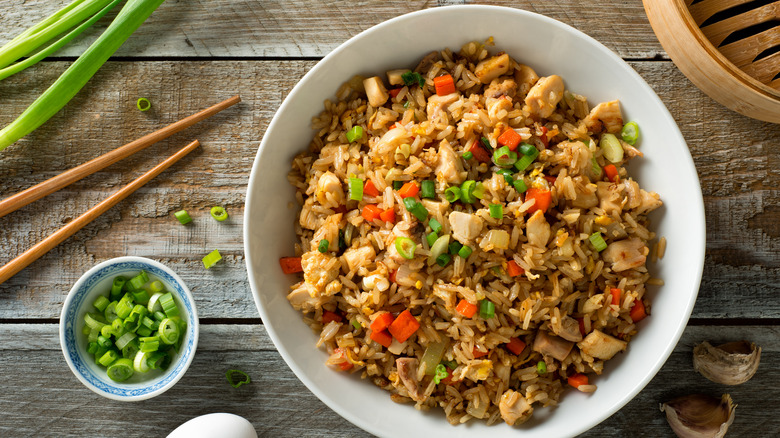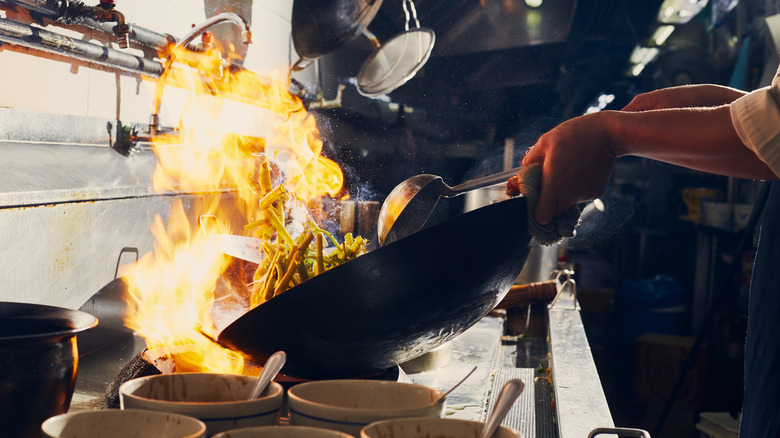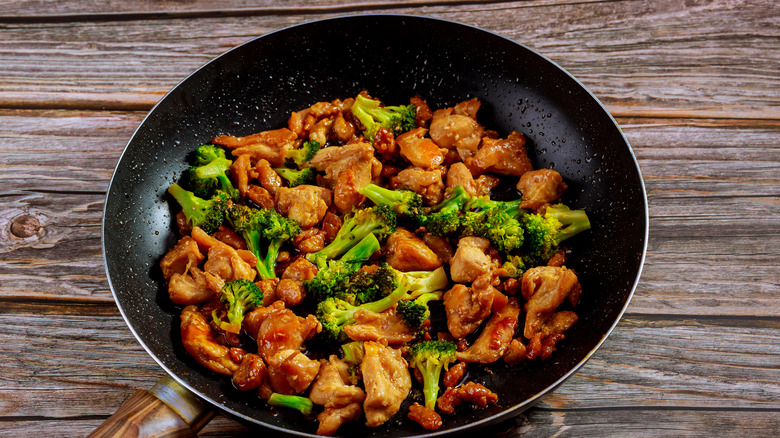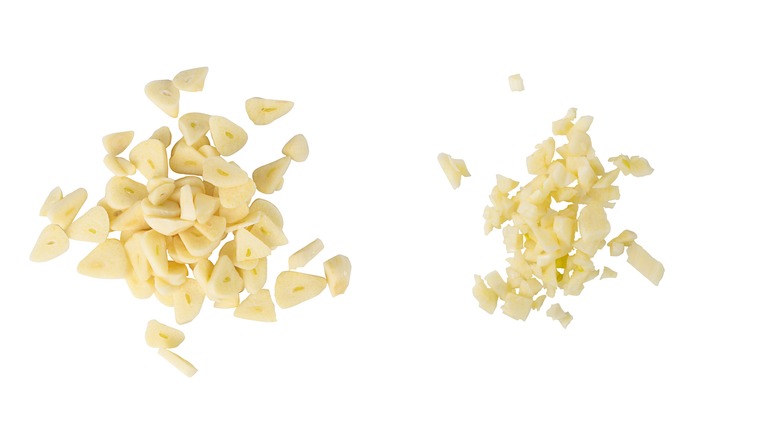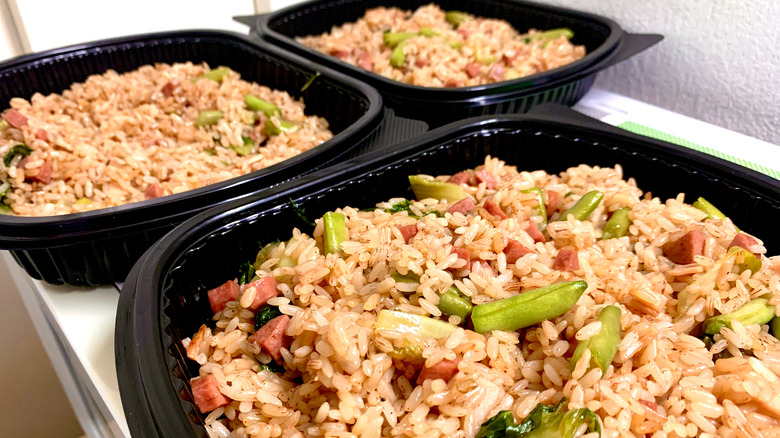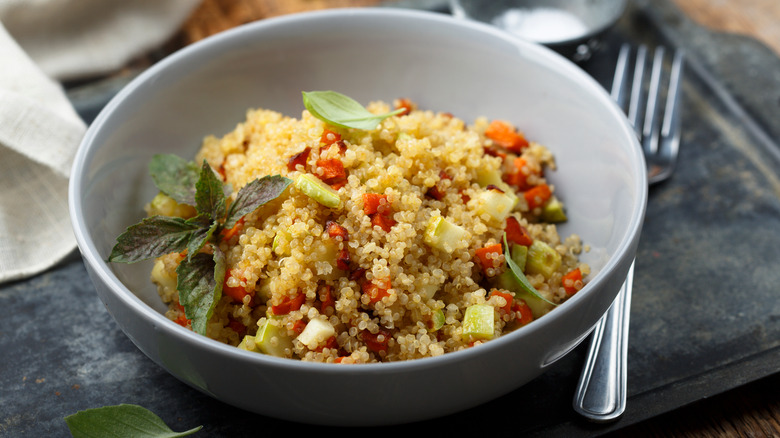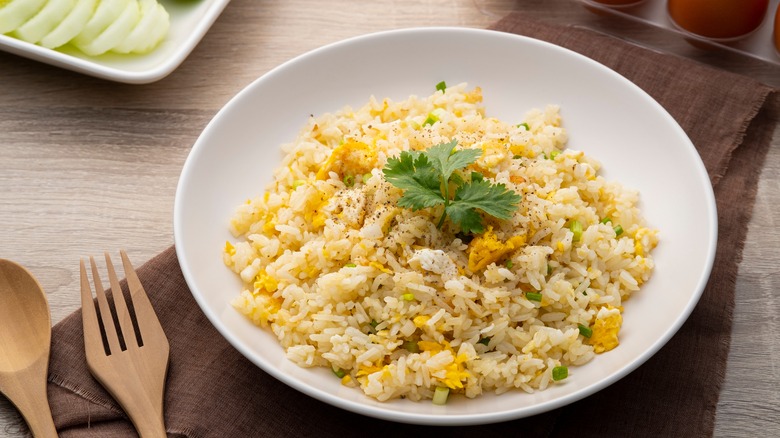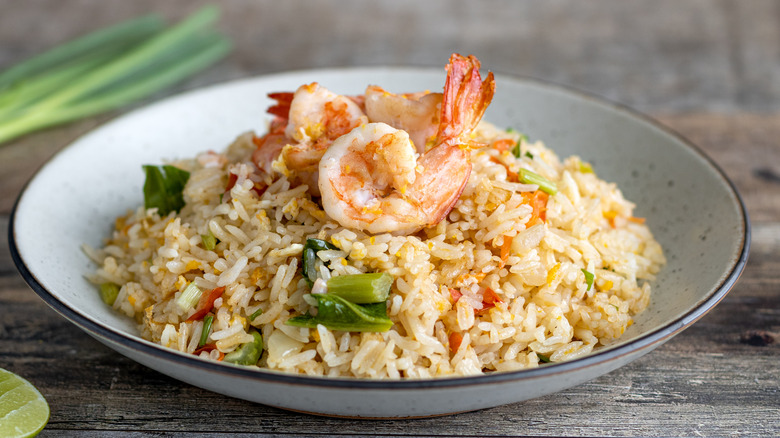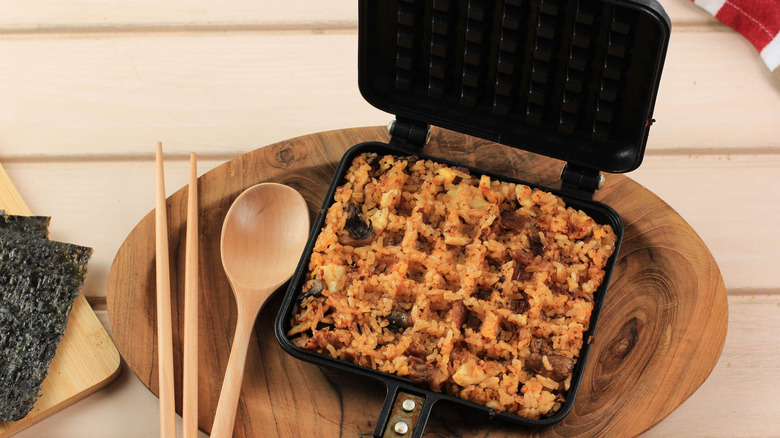15 Mistakes You're Making With Fried Rice
Imagine the smells of a Chinese takeout restaurant wafting through your nose. What are you ordering off the expansive menu? Crab Rangoon? Boneless spare ribs? No matter your go-to order, you can't help but order a pint of fried rice to go with it.
Fried rice is a humble food found in most Chinese restaurants. Although the original fried rice recipe originated and popularized in 6th century China to use leftover rice, it has since expanded beyond the country's borders and over oceans to your local Chinese takeout joint, where it is often prepared with peas, carrots, and chopped protein. Now, you can find renditions of fried rice worldwide with a myriad of grains, protein, veggies, and seasonings mixed in.
Fried rice is a simple dish, but some tricky bends can produce a watery plate with poorly-cooked mix-ins. Here are some of the biggest mistakes you must avoid when making homemade fried rice.
Using fresh rice
When it comes to cooking, we often live by the expression "fresher is better." Fresher veggies, fresher meats — they all make for a tastier dish. But when it comes to fried rice, you'll need to take a step back. It's always better to use leftover rice for fried rice because the rice grains are allowed to dry out and subsequently firm up. Fresh rice is too moist and fluffy; thus, it will stick together in a clump when you add it to your wok. The resulting fried rice will also be sticky and gloopy rather than firm.
If you forget to make your rice ahead of time and add it to your refrigerator overnight — fear not! You can use a baking sheet to help dry out your rice grains before making your fried rice. First, spread the freshly cooked rice on a baking sheet for at least ten minutes at room temperature, then place the sheet in your refrigerator for an additional 20.
Omitting a dash of cornstarch
The secret ingredient to help you improve fried rice is cornstarch. Cornstarch's utility in the kitchen — to soak up moisture and thicken sauces — also applies to fried rice. Adding a dash of powder to your rice will help soak up the water from the grains, further drying your rice. This makes the rice easier to cook, resulting in less goopy fried rice than if the ingredient was omitted.
Besides separating the rice grains, cornstarch can serve other purposes in your fried rice recipe. Some restaurants will use cornstarch to seal the meat's moisture and make it crispier. If you notice you added slightly too much soy sauce or liquid seasoning to your fried rice, you can add some cornstarch to thicken it. The heat of the wok will prevent the slurry from condensing into a paste. Add your cornstarch slowly to your mixture since adding more cornstarch is always easier than removing it from the wok.
Using the wrong type of rice
There are tons of different rice varieties out there, including short, medium, and long grain. The best kind of rice to use for fried rice is medium-grain rice. Long-grain rice is too spindly and will dry out too quickly, while short-grain rice will is too wet and clumpy. Thai Jasmine, a medium-grain white variety, is perfect for making fried rice. If you choose to use short-grain rice, you should always rinse the rice several times to remove the starches; this is the main culprit for fried rice that sticks together.
There are some variations of fried rice that use long-grain rice. Nigerian fried rice is made with long-grain rice cooked in stock to absorb more flavors. The stock is brimming with spices and seasonings like curry powder, turmeric, and chili powder, which imparts a more aromatic and robust herbal profile. In addition, Nigerian fried rice includes unique proteins like liver and prawns, as well as a splash of coconut milk.
Improperly storing your rice
The rice in your fridge may not seem like it can make you sick, but it is actually one of the more dangerous types of food to reheat. This is because improper rice storage can lead to a proliferation of the Bacillus cereus bacteria. If you leave rice for too long at room temperature, you risk bacterial spores multiplying and leaving behind toxins that can cause gastrointestinal upset. To prevent spreading Bacillus cereus, you should always cool rice within an hour of preparing it. You should also avoid leaving your rice in the fridge for over a day before using it.
There are also many signs that your cooked rice has gone bad. Visible mold or changes in the color of your rice can indicate that it is time to throw it away. If you get as far as to do a taste test, you'll notice that spoiled rice will have a slimy texture and off-putting aroma.
Not using a wok
A wok is the only instrument that you should use to make fried rice. Woks are made with a thin metal, thus having exemplary heat distribution compared to other fry pans. Plus, the steep sides allow the user to stir and flip the food inside the wok without worrying about flipping it onto the stove or the countertop next to them. The curved shape of the wok is best used for cooking over a gas flame, but several wok models allow users to use them over an electric or induction stove.
If you don't have a wok handy, you can use a large skillet instead. You'll want to ensure the skillet you're using is large enough to cook with; this will prevent you from tossing your rice out of the pan, causing you to steam the rice rather than fry it. Of course, having a too-large pan is always better than a too-small pan.
Forgetting to toss the rice
How do you get perfectly cooked fried rice with a home wok? It's all about how you toss the rice in the pan. The secret to making perfect fried rice is not to stir the ingredients in the pan. Instead, it's to toss the rice in the wok. The frequent tossing motion of the rice will allow it to cook, but not to the point where it burns. A study published by The Royal Society Publishing notes that the repetitive tossing motion typically occurs three times per second, with the chef rocking both back-and-forth and to-and-from. The more rapid the movement of the wok, the quicker the rice cooks.
If you're trying this method at home, you'll want to ensure you work with a hot enough wok. If your wok is not hot enough to start with, you'll find that the rice will steam faster than it cooks. Granted, your home stove will likely not get to the same temperatures as a commercial gas stove at a restaurant. Fried rice often tastes better at a restaurant than at home because of wok hei — a term used to describe how the physics and temperature of the wok impart a smokey flavor to the food.
Adding too much stuff to your fried rice
Although it might seem like you can include everything but the kitchen sink in your fried rice, you need to be cognizant of the ingredients you add to it — and how much of each you're adding. Likewise, regarding veggies and proteins, you'll want to ensure you can get a little of everything in each bite.
Working with liquid seasoning is much more challenging. Adding too much liquid seasoning will mean your fried rice will steam rather than fry. Therefore, you'll want to keep your ingredients on the dry side of things. Add as much soy, oyster, or fish sauce as your recipe denotes (we recommend using light soy sauce to prevent darkening your rice too much) and seek flavor from elsewhere. One of our favorite additions to fried rice is monosodium glutamate (MSG). Even a scant teaspoon of MSG added to your fried rice can help amplify the umami richness without making it too soggy.
The smoking point of your oil isn't high enough
Choosing the right oil to make your stir fry with is all about chemistry. You'll want to select oil to stir fry with a high smoke point. The smoke point is the temperature at which the oil breaks down and becomes smokey. Not only does this phenomenon cause a bitter or burnt flavor, but it can also release free radicals that negatively impact human health. Butter has one of the lowest smoke points of all fats at around 302 degrees Fahrenheit, which is no match for a hot pan. Olive oil, especially extra virgin olive oil, is unsuitable for cooking fried rice.
The best oils for fried rice include canola oil, peanut oil, and unrefined avocado oil because they all have high smoke points. If you want a sesame flavor undertone in your fried rice, add sesame oil to your rice after removing it from the heat.
You forgot to cook your ingredients beforehand
Vegetables and proteins are the textural (and flavor) elements that your fried rice needs. However, adding these ingredients without care can cause you to alter the texture of your fried rice negatively. You should never add raw vegetables or proteins to your fried rice; the odds are that it will not cook fast enough, leading you to either overcook your rice or undercook your proteins and vegetables. And while the risk of undercooking vegetables is just a crunchy carrot piece here and there, undercooking meats can potentially make you sick.
You should cook your vegetables ahead of time and place them in a side dish before adding them back into the rice. In addition, you should chop your veggies and proteins into small pieces so they cook quicker. Also, you should choose ingredients to add to your stir fry that will stay intact when cooking. For example, you won't see fish used in fried rice because it will disintegrate when tossed with the other ingredients.
You're not adding enough aromatic ingredients
Aromatic ingredients are an easy way to elevate the taste and flavor of your fried rice. One of our favorite ingredients to add to fried rice is garlic. The sharpness of this ingredient contrasts the proteins and the other vegetables well — without becoming too distracting. We recommend sauteing the garlic and onions together in the oil before adding the rest of your ingredients to help infuse more aromatic flavors into the oil.
Another unique ingredient to add to your fried rice is kimchi. Our kimchi fried rice recipe is made with the Korean fermented staple and gochujang — a spicy chili paste. The recipe starts with rendering bacon with aromatics like garlic, onion, and ginger before adding the rice and the kimchi. Then, the dish is topped with gochujang-infused butter, a fried egg, and scallions. It's a spicy meal idea that can elevate your leftover rice!
Reheating it in the microwave
The general policy regarding reheating food is trying to reheat it similarly to how you cooked it. For example, in a pinch, reheating your fried rice in the microwave can work. However, you'll find that you must stir the rice constantly to mitigate the hot spots and risk your rice getting soggy. If you go the microwave route, keep a glass of water near the bowl to release the steam and keep your rice fluffy.
Instead of reheating your rice in the microwave, we recommend pulling out your wok. It's the best way to reheat fried rice because you won't have to worry about overcooking it. Add a few tablespoons of oil to the skillet or the wok, and cook your rice for a few minutes until warm. If you're cooking for a crowd, use a larger pan to reheat your rice and add a spoonful of water for each cup of rice you have. Cover and let the rice simmer over a low flame until warmed through.
Only thinking you have to use rice
Fried — rice? Kind of intuitive to only think that you should use rice. But, there is a whole world out there of making fried rice — just without the rice. We recommend trying to make quinoa fried rice as a starter. Quinoa is a grain rich in protein and fiber, meaning that it will keep you full for longer than starchy, carbohydrate-rich rice.
Just like if you were to use rice for this recipe, you should first let the quinoa dry out for a few days in the fridge before adding it to your wok. Then, cook your vegetables and protein first before adding your quinoa to the mixture. If you want more flavorful quinoa, we recommend cooking it in broth rather than plain water. If you like the "meatiness" of medium or short-grain rice, you can also try using pre-cooked farro for fried rice. It has a nutty flavor than rice but absorbs liquid seasoning just as well.
You don't add the egg at the correct time
There is a lot of debate about when to add eggs to fried rice. The egg is an essential protein to use in fried rice; some would even argue that fried rice isn't truly "fried rice" without it. There are two schools of thought: cooking the eggs ahead of time versus stirring the raw eggs with the rice before cooking. The former will give you small chunks of eggs spread evenly throughout the dish, while the latter will result in each rice kernel being covered in a shade of eggy gold.
If you plan to make the eggs ahead of time, you can cook them to your liking and then add them back into the mixture before you're about to serve it. However, if you want to cook the two of them together, you should plan to mix the eggs in with the rice as soon as possible to prevent the proteins from forming chunks separate from the rice.
You don't get creative with your proteins
One of the best things about fried rice is that your unique combination of proteins, veggies, and seasoning makes this dish all your own. If you're repeatedly using the same type of protein, you may get bored with your fried rice. You can also use leftover meat in your stir fry to help cut down on your food waste. If you have leftover minced pork from making meatballs, you can fry it and incorporate it into pork fried rice. Seafood lovers will enjoy the taste of succulent shrimp fried rice topped with a warm, oozing fried egg.
Fried rice is an easy meal to make vegan, too. You can use tofu or tempeh cubes to add texture and plant-based protein to your dish. If you like a meat-like chew to your fried rice, we recommend freezing your tofu and letting it thaw in the refrigerator. This will create air bubbles in the tofu and a sponge-like texture that quickly absorbs your seasonings.
Not trying to waffle-ize your fried rice
We're always looking for ways to combine breakfast and dinner. If you struggle to think of a savory breakfast idea, add fried rice to a waffle maker. It's a unique way to liven up leftover fried rice for breakfast and only takes one ingredient. Simply heat the greased waffle iron and pour your fried rice onto it cold. Then, use a spatula to carefully even out your pile of rice before closing the lid down on the waffle maker. After less than five minutes, your waffle will be firm and crispy on all sides and the perfect vehicle for a breakfast sandwich or to eat as a side dish. You can also enhance your fried rice by adding extra raw eggs, seasonings, and chives before spreading it onto your waffle iron and cooking.
Static Media owns and operates Tasting Table and Mashed.
